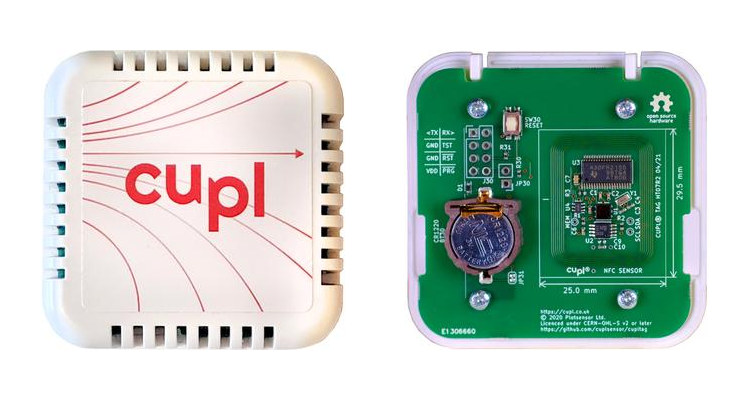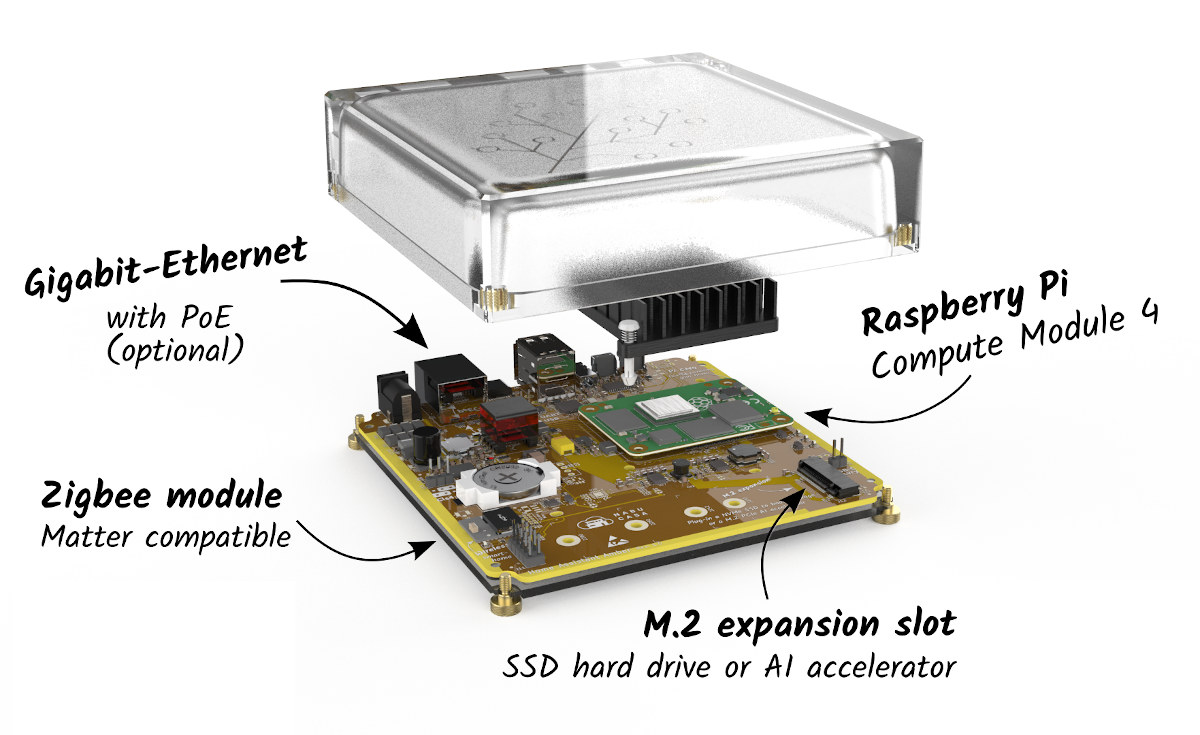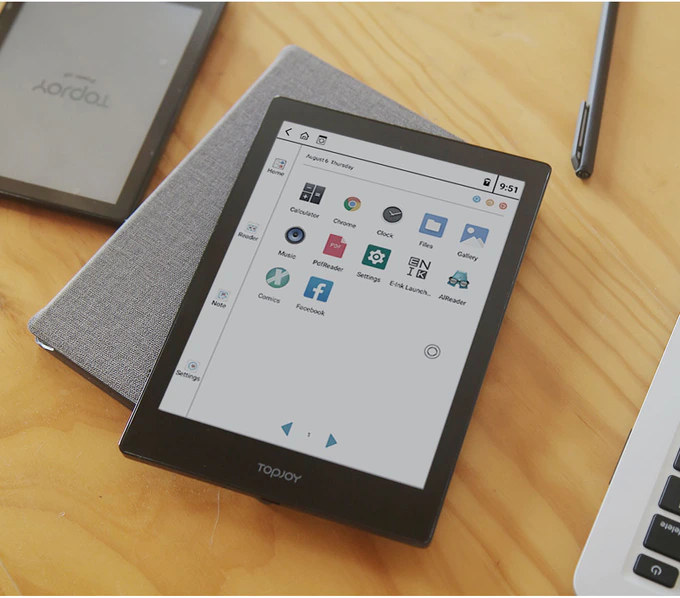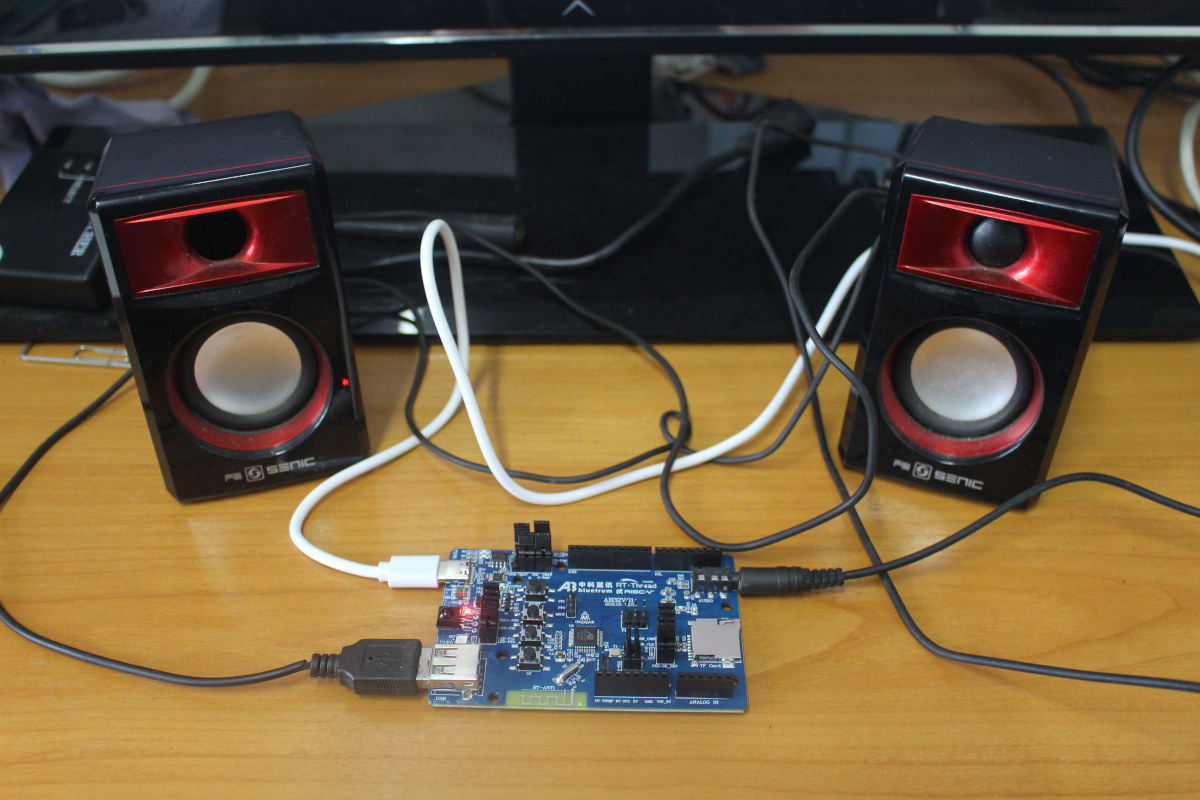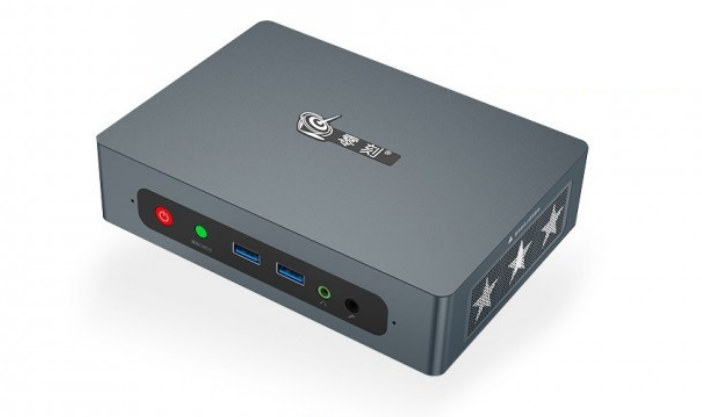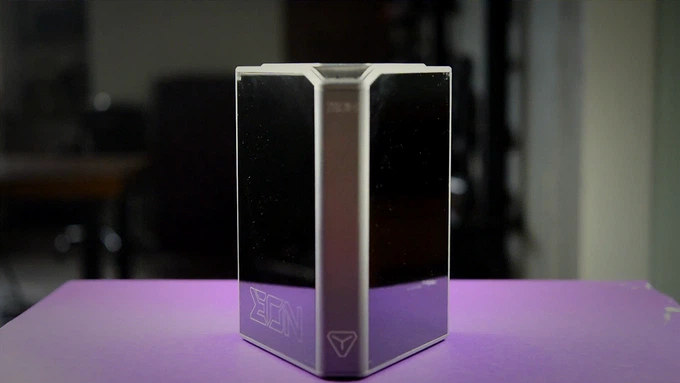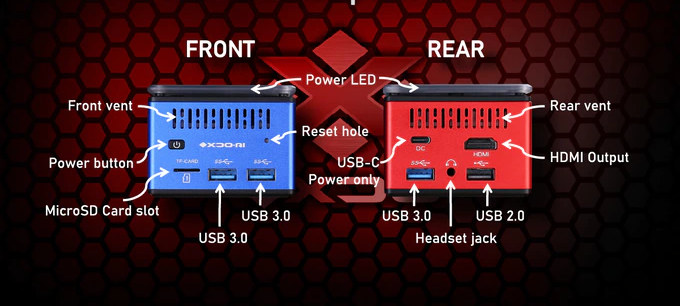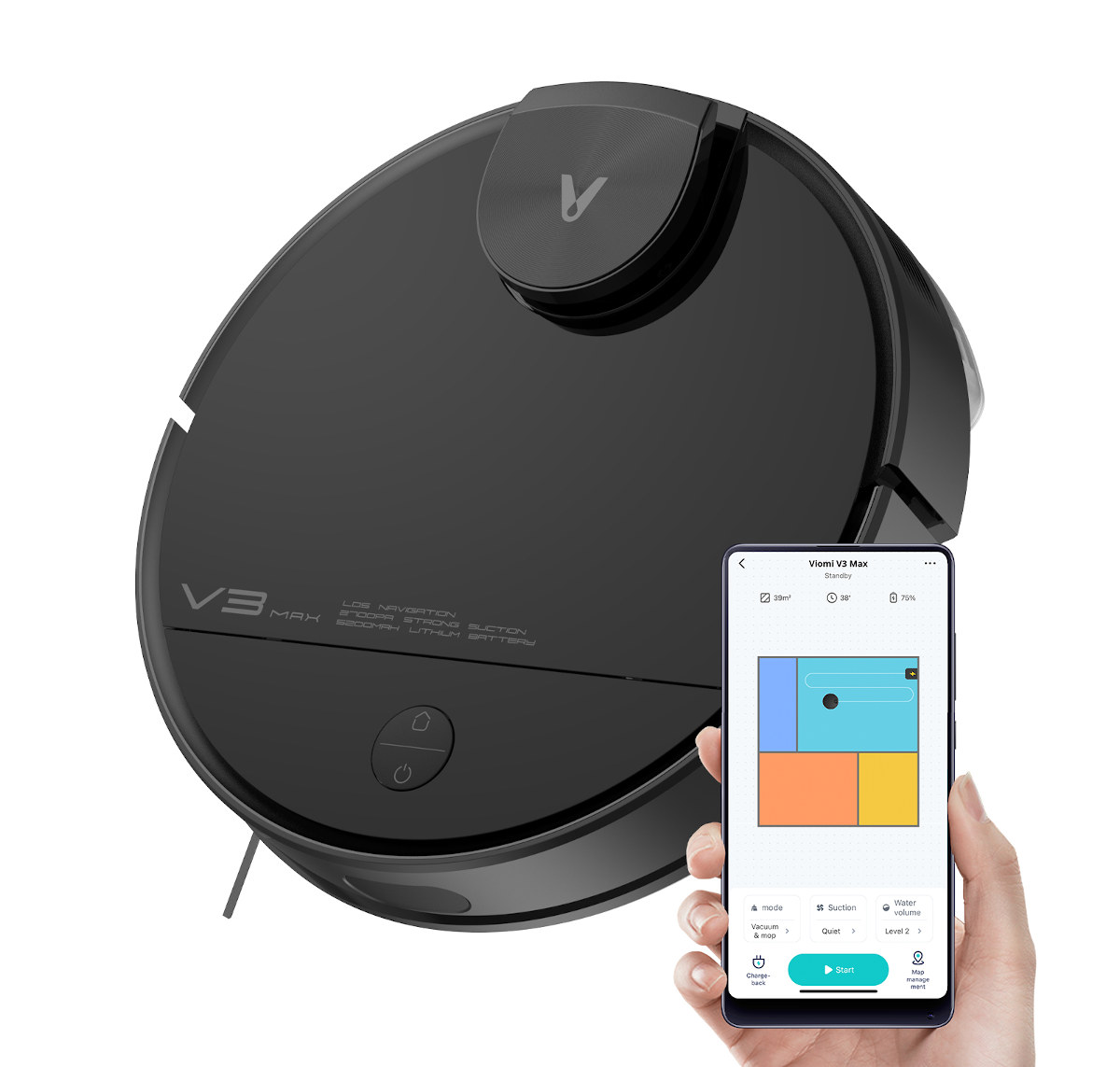Temperature and humidity sensors would normally connect to a gateway sending data to the cloud, the coin-cell battery-powered cuplTag NFC tag instead sends data to your smartphone after a tap. CulpTag is controlled by an MSP430 16-bit microcontroller from Texas Instruments which reads and stores sensor data regularly into an EEPROM, and the data can then be read over NFC with the tag returning an URL with the data from the sensor and battery, then display everything on the phone’s web browser (no app needed). cuplTag specifications: MCU – Texas Instruments MSP430FR2155 16-bit microcontroller @ 24 MHz Storage – 2K bytes EEPROM part of NT3H2111 for up to 188 temperature & humidity data points or 376 temperature-only data points Connectivity – Passive NFC, tap-to-read via NXP NT3H2111 NFC tag Sensors – HDC2021 temperature and humidity sensors Measurement interval – 3 minutes to 65535 minutes (Default: 10 minutes) Battery – CR1220 battery […]
Home Assistant Yellow – A Raspberry Pi CM4 based automation gateway (Crowdfunding)
The team behind the popular Home Assistant open-source home automation framework has just launched their second hardware with Home Assistant Yellow automation gateway based on Raspberry Pi CM4 module. This follows last year’s ODROID-N2+ based Home Assistant Blue which was a limited edition and has now been discontinued, albeit still supported. The carrier board for Home Assistant Amber is designed from scratch and notably includes Silicon Labs MGM210P Mighty Gecko Module with support for Zigbee 3.0, OpenThread, and Matter (Soon), as well as M.2 socket that can take an NVMe SSD, or an AI accelerator card. Home Assistant Yellow specifications: Supported SoM – Raspberry Pi Compute Module 4 (CM4) with Broadcom BCM2711 quad-core Cortex-A72 processor @ 1.5 GHz, up to 8GB RAM, up to 32GB storage. (Note: optional WiFI 5 and Bluetooth 5.0 connectivity not covered by regulatory approval) Storage – Support for NVMe SSD via M.2 socket, bootable for […]
TopJoy ButterFly is a Full-Color DES Screen e-Reader with Android 11 (Crowdfunding)
TopJoy ButterFly is a full-color DES screen e-Reader running Android 11 on a quad-core Cortex-A55 processor that appears to be the same Rockchip RK3566 processor used in the upcoming PineNote e-reader. Two models of the e-Reader are offers with E601 fitted with a 6-inch display and E701 with a larger 7.8-inch display both offering 300 PPI for black & white content and 150 PPI for color, and equipped with 2GB RAM & 32GB storage by default, an option for 4GB RAM and 64GB storage for the larger display. TopJoy Butterfly specifications: SoC – Rockchip RK3566 quad-core A55 processor up to 1.8 GHz with Mali-G52 EE GPU, 0.8 TOPS AI accelerator System Memory – 2GB RAM (option for 4GB for E701) Storage – 32 GB eMMC flash (option for 64GB for E701) Display E601 – 6-inch DES color e-Paper display with 1072 x 1448 resolution; 150 PPI for color, 300 PPI […]
Getting started with Bluetrum AB32VG1 RISC-V Bluetooth audio board using RT-Thread
Bluetrum AB32VG1 is a development board based on AB5301A RISC-V microcontroller designed for Bluetooth audio applications as well as general-purpose projects that works with RT-Thread real-time operating system. RT-Thread sent me a board for review, and I’ll write about my experience in a getting started guide for Bluetutm AB32VG1 trying out the RT-Thread Studio IDE with the LED blink and audio samples, as there’s no Bluetooth sample at this time… Bluetrum AV32VG1 Unboxing The board ships with a USB-C cable for power and programming. It offers Arduino UNO headers for expansion, a MicroSD card slot, a USB host port, a 3.5mm audio jack, an IR receiver, and a few buttons. There’s nothing to do on the bottom of the board apart from a QR Core for the WeChat app. There are also several configuration jumpers, but I could not find any documentation about these and did not mess with the […]
Beelink LZX – A Zhaoxin KX-6640MA based x86 Mini PC you may never see
Beyond Intel and AMD, there are other x86 processors in the wild from DM&P and Zhaoxin. We’ve written about the latter in a QNAP NAS earlier this year, but now it turns out there’s also a Zhaxin-based mini PC with Beelink LZX based on a Zhaoxin KX-6640MA quad-core x86 processor that showed up on Shopee Indonesia for 3.86 million Indonesian Rupiahs, or about $270 US. The computer comes with 8GB RAM by default but supports up to 64GB, as well as dual M.2 NVMe and SATA III storage, two 4Kp60 capable HDMI ports, dual Gigabit Ethernet, and more. Beelink LZX specifications: SoC – Zhaoxin KX-6640MA quad-core processor @ 2.1 GHz / 2.6 GHz (Turbo) with 4MB cache, C-960 Graphics (support 4K HD); TDP: 25W System Memory – 8GB DDR4 RAM upgradeable to 64GB via two SO-DIMM memory slots Storage – 256GB M.2 NVMe SSD, additional M.2 2280 slot for NVMe […]
Argon EON – A 4-Bay NAS for Raspberry Pi 4 (Crowdfunding)
Argon EON is a 4-bay network access storage (NAS) enclosure designed to work with Raspberry Pi 4 that follows other popular Raspberry Pi cases from the company including the Argon One and Argon One M.2. Also known as the Argon EON Pi NAS, the enclosure features four SATA hard drive ports that will fit two 3.5-inch SATA HDD and two 2.5-inch SATA for a maximum capacity of up to 40 TB with consumer-grade drives, although I suppose it’s not a hard limit. Argon EON Pi NAS specifications: Supported SBC – Raspberry Pi 4 SBC with Broadcom BCM2711 quad-core Cortex-A72 processor, up to 8GB RAM Storage 4x SATA drive bays with up to 2x 3.5-inch HDD, and up to 2x 2.5-inch SSD/HDD with up to 10TB capacity per drive MicroSD card socket (for OS) Video and audio outputs – 2x full-size HDMI 2.0 ports up to 4Kp60, AV jack with composite […]
Pantera Pico PC ultra-compact mini PC ships with Windows 10 or Ubuntu (Crowdfunding)
The Pantera Pico PC is an ultra-compact Gemini Lake Refresh mini computer similar to the Chuwi Larkbox Pro, that was supposed to launch in December 2020 through an Indiegogo campaign. Let’s say there have been delays, and the company – XDO Tech – has only just launched the Pico PC on Kickstarter for $149 and up. Pantera Pico PC specifications: SoC – Intel Celeron J4125 quad-core Gemini Lake Refresh @ 2.0 / 2.7 GHz (Turbo) / 2.4 GHz (Turbo all cores) with Intel UHD Graphics 600 @ 250/750 MHz; 10W TDP System Memory – Dual-channel 4GB or 8GB LPDDR4 Storage – 64 GB to 1TB M.2 2242 SSD, MicroSD card socket Video Output – HDMI 2.0 up to 4Kp60 Audio – 3.5mm speaker/microphone jack, digital audio via HDMI Connectivity Dual-Band WiFi (allegedly WiFi 6, but limited to 422 Mbps?), Bluetooth 5.1 USB – 3x USB3.0, 1x USB2.0 Misc – Power button, […]
Viomi V3 Max – A 3-in-1 sweep, mop and vacuum cleaner robot (Sponsored)
The Viomi V3 Max Robot Vacuum offers more than your typical Lidar robot vacuum cleaner as it features three functions, namely sweep, mop, and vacuum cleaner. It can even combine sweep & mop modes to thoroughly remove dust, dirt, water stains, crumbs, pet hair, and footprints on diversified floors. The Viomi V3 Max is born for mopping with an exclusive deep cleaning algorithm running on the Cortex-A35 processor powering the appliances, mimicking the manual way of mopping with 97.5% of cleaning coverage in order to ensure stubborn stains are removed without damaging the floor. An Auto Boost Mode enables perfect carpet cleaning with suction power automatically boosted to 2700Pa. The vacuum cleaner can either be fitted with 2-in-1 dust and water tank (400ml dust bin + 200ml water tank) to enable sweeping and mopping at the same time or an optional super-sized 700ml water tank that is large enough to […]


